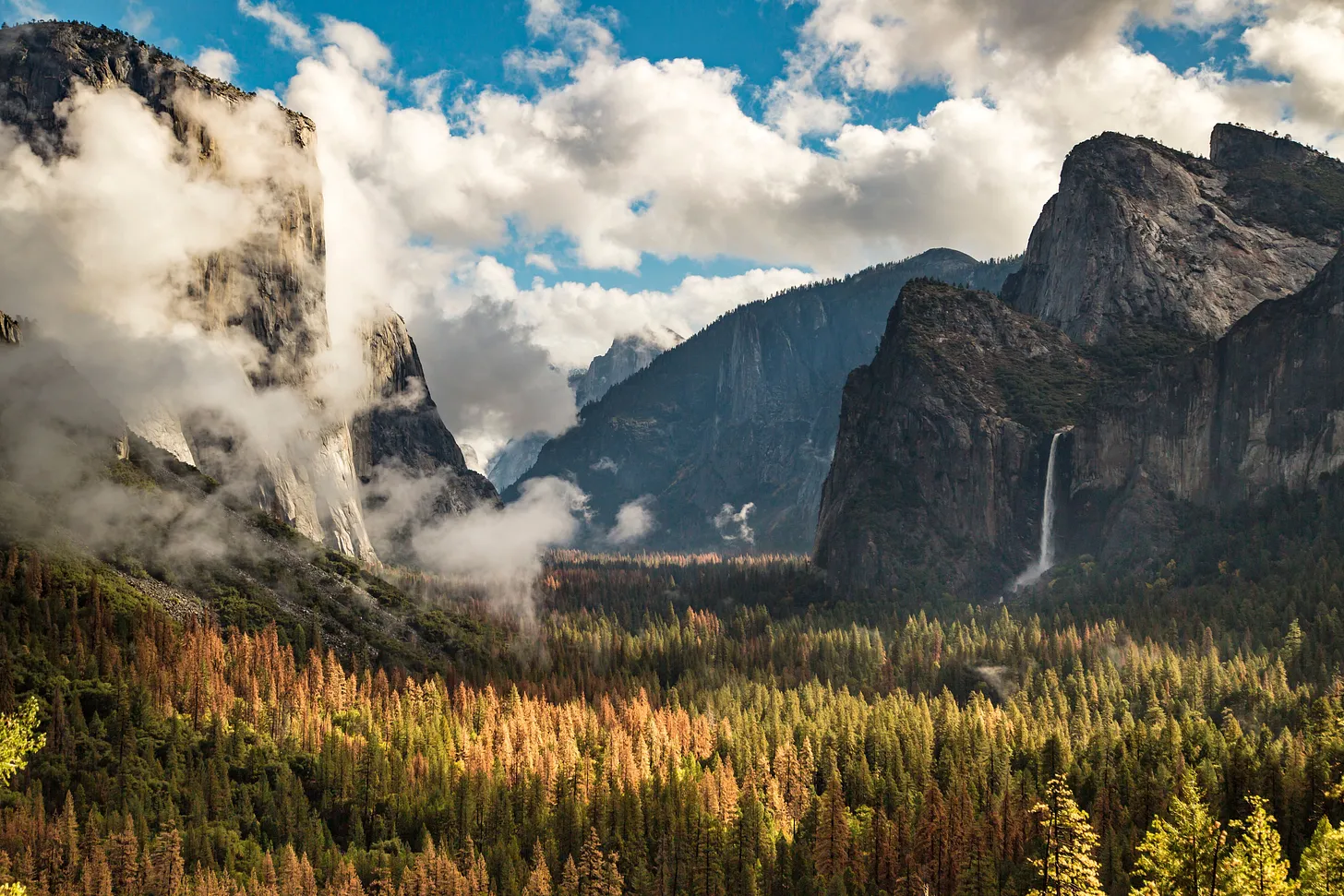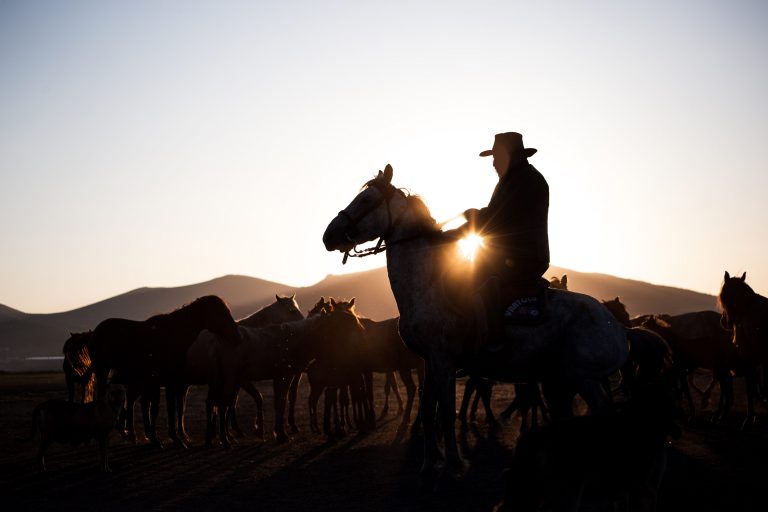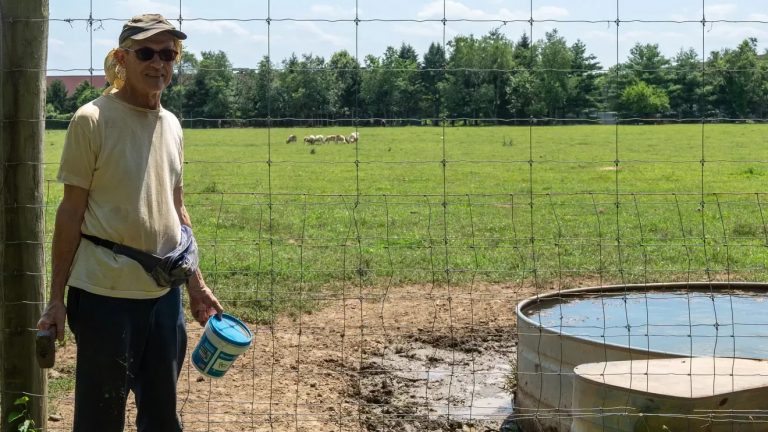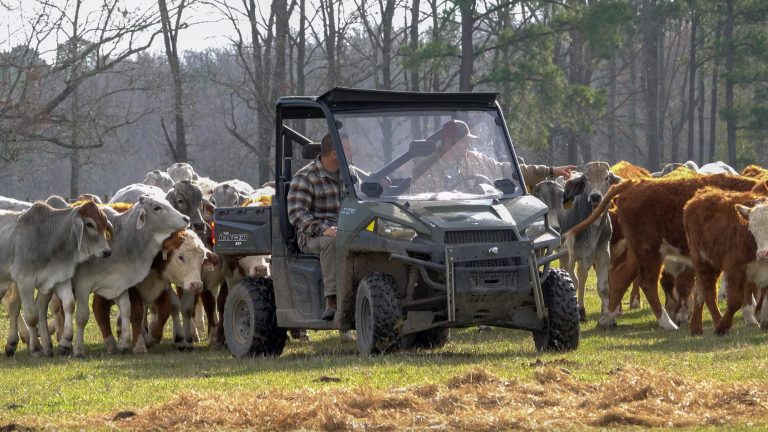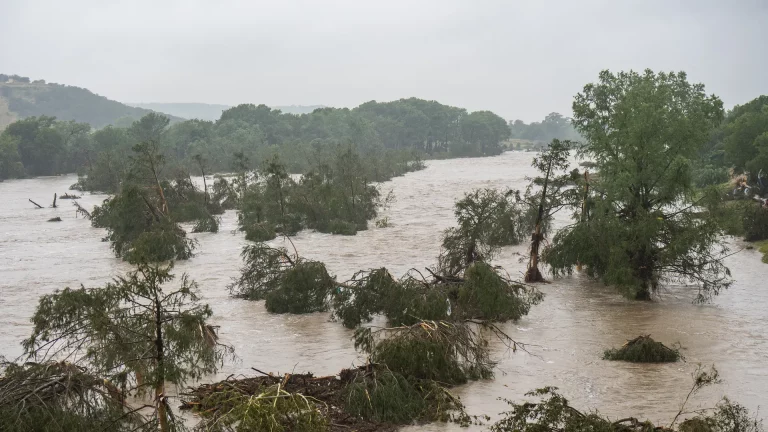Yanasa TV News
Farmers, Ranchers, and Local Leaders Warn of Lost Control as Washington Deregulates Land Use and Technology
A sweeping new federal law, recently signed by President Trump, has triggered nationwide debate by ordering the sale of millions of acres of public land, promising to tackle America’s housing crisis, and ushering in a decade-long ban on local regulation of artificial intelligence systems. Proponents argue the law will unleash economic growth and innovation. But across rural America, skepticism is growing as ranchers, farmers, tribal leaders, and community advocates raise alarms about who stands to benefit—and who is left behind.
Public lands have long been one of the few unifying threads in American life, valued by citizens across the political spectrum regardless of party, region, or income. The idea that these spaces are “held in trust for all” is central to the national identity—and helps explain why threats to public land ownership draw such passionate responses from a wide range of Americans.

A Nation’s Legacy: Why So Much Land Is Public—and Why It Matters
To understand why the stakes are so high, it helps to remember how America’s public lands came to be. Throughout the 19th century, Congress granted millions of acres to railroads, veterans, homesteaders, and states to promote settlement and industry (USFS History). But as the West filled in, Americans increasingly saw the need to conserve wide-open spaces. The creation of the U.S. Forest Service in 1905 and the Bureau of Land Management in 1946 marked the federal government’s formal commitment to managing hundreds of millions of acres as a public trust (Congressional Research Service).
Over time, the philosophy of “public lands for public good” took root. These lands became the backbone of rural economies, offering grazing for ranchers, watersheds for towns, recreation for hunters and anglers, and a vast reserve for wildlife. Past attempts to privatize or sell off these lands, like the Sagebrush Rebellion of the 1970s–80s and land disposal efforts under Presidents Reagan and Bush, met fierce resistance—not only from environmentalists, but also from rural residents who feared losing access and a voice in how the land was managed (High Country News). The lesson was clear: public land policy is deeply personal and fiercely defended, especially in the West.
But despite these ideals, mistrust has steadily grown between rural communities and federal land agencies. Many ranchers and tribal members argue that the U.S. Forest Service and Bureau of Land Management have become increasingly overreaching—implementing top-down rules, restrictive grazing permits, and land use policies that often ignore local realities and historical stewardship. In places where livelihoods depend on access to public lands, heavy-handed enforcement and bureaucratic red tape have frayed the social contract. Meanwhile, tribes with ancestral ties to these lands and ranchers have long been sidelined in decision-making, even as federal agencies tout collaboration. What’s needed now is meaningful reform—one that replaces mistrust with transparency, empowers local voices, and fosters genuine partnerships between ranchers, tribes, and land managers. Only through shared responsibility can the promise of public lands truly serve the public good.
Adding to the tension is a longstanding objection among some legal scholars, landowners, and Western politicians who question whether the U.S. government should own such vast expanses of land in the first place. Critics argue that federal control over nearly one-third of the nation’s landmass—much of it concentrated in the West—was never intended by the framers of the Constitution. They point to the Constitution’s Property Clause (Article IV, Section 3) as granting the federal government limited authority to hold land for enumerated purposes, such as forts, arsenals, and federal buildings, not indefinite control over millions of acres for general management. While the Supreme Court has upheld broad federal land authority, this constitutional debate continues to fuel calls for decentralization, greater state or local control, and a reevaluation of the federal land estate. For many in the West, the question isn’t just how public lands are managed—but who has the right to manage them at all.
Putting ideology aside, the real story behind recent pushes to sell or repurpose public lands may be less about constitutional theory and more about emerging economic agendas—particularly the quiet but aggressive expansion of corporate infrastructure tied to artificial intelligence. As tech companies race to build out the next generation of AI, they need something more than algorithms: vast physical resources, including land for massive data centers, water for cooling systems, and energy corridors for high-voltage transmission lines. Rural areas, especially those with underutilized public lands, have become prime targets for these developments. With promises of jobs and investment, corporations often court local officials and federal agencies behind closed doors—setting the stage for what critics call a 21st-century land grab. The shift isn’t about privatization; it’s about transformation. Public lands once seen as ecological reserves or grazing commons are being quietly repositioned as industrial zones for digital infrastructure. This trend raises urgent questions: Who benefits from these sales? What’s the long-term cost to local communities? And are we sacrificing public trust for corporate control in the name of innovation?
Massive Land Sales: Opportunity or Upheaval?
The centerpiece of the new law is a provision directing the Bureau of Land Management and U.S. Forest Service to identify and sell between two and three million acres of public land. While the law’s backers describe this as a way to unlock land for affordable housing, the scope of the bill goes much further: up to 250 million acres are made eligible for nomination and future sale, encompassing vast swaths of the rural West (ZeroHedge; BLM Fast Facts).
For generations, these public lands have supported ranchers with grazing leases, sustained wildlife habitats, and provided open spaces for rural communities. Selling off large tracts of public land raises fears that auctions will be dominated by large investors, developers, and corporate interests, rather than local families, small farmers, or affordable housing groups. With increased competition, land prices could climb even higher, making it more difficult for working ranchers and beginning farmers to secure land or renew leases.
Underlying this debate is a deep skepticism over who stands to gain from large-scale land sales. Critics point out that many of the politicians most actively supporting the bill—including Senator Mike Lee—receive significant campaign funding from real estate, private equity, and technology sectors. Microsoft, a major acquirer of land for data centers and AI infrastructure, and Blackstone, a global real estate powerhouse, rank among the top contributors to lawmakers pushing this legislation. These financial connections have fueled widespread distrust and sharpened concerns that large corporate actors, rather than working families, will ultimately reap the rewards of privatizing public lands.
While the bill’s supporters cite the national housing shortage as justification, there are no real requirements that buyers must actually develop affordable housing, or even use the land for residential purposes. Without strict provisions and oversight, much of the land could end up converted to luxury homes, sprawling subdivisions, commercial projects, or even speculative holdings, with little benefit for struggling families or the rural communities that have long depended on those lands (E&E News).
Adding to the uncertainty, the bill allows for the sale of public land within five miles of a “population center”—yet leaves that term loosely defined, creating ambiguity about which lands are truly at risk. With no specific parcels yet identified, projections for how much land could ultimately be sold vary wildly, from two to three million acres to, in some media accounts, hundreds of millions. This lack of clarity has made it difficult for communities, tribal governments, and conservationists to assess the full impact or mount organized resistance in advance.
In the end, the law may transfer some of America’s precious assets—the lands held in trust for everyone—into corporate hands. For rural communities, this represents not just an economic loss, but a loss of heritage, opportunity, and a say in the future of their own landscape.
Tribal Lands and the Threat to Sovereignty
For Indigenous nations, the law raises fresh fears of dispossession and cultural erasure. Many public lands overlap or border tribal territories or contain sites of historical and spiritual significance (National Geographic). In the past, land transfers have rarely included meaningful consultation with tribal governments, despite treaties and federal trust responsibilities. As a result, tribes worry that accelerated sales will mean further loss of ancestral lands, reduced access to natural resources, and new threats to sacred sites.
Recent fights over places like Bears Ears National Monument in Utah and Oak Flat in Arizona have shown how tribal interests are often sidelined by federal decisions (ICT News). Leaders from the Navajo, Ute, Hopi, and San Carlos Apache tribes have publicly opposed land deals that they argue violate their sovereignty and threaten both cultural survival and water rights. The new law could accelerate these conflicts, especially if developers target lands with unclear or contested histories.
Amid debate over the scale of the selloff, late-stage amendments have attempted to reassure critics—for instance, with promises to exclude National Forest lands from the bill’s scope. However, many local leaders and advocacy groups remain skeptical, noting that such provisions can be changed quietly or reversed in later legislative sessions. The lack of clear, enforceable guarantees continues to breed suspicion in communities that have seen past promises broken.
Transparency, Accountability, and the Public’s Right to Know
The land sale process itself has come under fire for a lack of transparency and genuine public participation. Critics point to a pattern of short or poorly publicized comment periods, opaque auction procedures, and limited opportunities for local governments, tribes, and citizens to weigh in before deals are finalized (The Hill).
Open government advocates warn that once land is sold, tracking how it is used—or misused—can become nearly impossible. “We’ve seen time and again that when public land is sold behind closed doors, communities are left out of the loop and promises are broken,” says Sarah James, a land-use watchdog in Colorado (Western Priorities). While some journalists and advocacy groups work to monitor the aftermath, accountability remains weak, and legal recourse is limited if land is diverted from its stated purpose.
The Affordable Housing Question—and the Resource Squeeze
The bill’s supporters say the sale of public lands will create a new supply of building sites, particularly near growing cities where housing is most expensive. But critics argue that much of the land eligible for sale is remote, lacks infrastructure, or is better suited for ranching and conservation than development (Nevada Public Radio). Without mandates tying land sales to affordable housing projects, rural leaders worry the law could deliver profits for large developers but little real help for families priced out of the housing market.
Despite assurances that the land sale will unlock affordable housing, the law contains no firm requirements for how newly corporatized parcels must be used. There are no mandates to ensure lots go to first-time buyers, no restrictions on minimum or maximum lot size, and no standards to prevent developers from purchasing large tracts for luxury homes or speculative investment. As a result, advocates for working families and rural communities fear the policy will do little to relieve actual housing pressures and could instead drive more high-end or absentee development in previously undeveloped areas.
The question of natural resources—especially water—is at the heart of the debate. In the West and other arid regions, water rights are already fiercely contested, and most public lands are not accompanied by guaranteed access to reliable water supplies (USGS). When new housing developments are approved on former public lands, it can mean thousands of new wells, expanded demand for municipal water, and increased pressure on already-stressed rivers and aquifers (AP News).
For rural communities and family farms, this creates real concerns about the long-term sustainability of their own water resources. Many existing farms and ranches operate on tight water allocations, and the sudden introduction of large housing developments—or even speculative land purchases—can lead to reduced availability, increased prices, or regulatory changes that restrict traditional uses. This tension often plays out in water districts, local courts, and state legislatures, but with federal land now more easily converted to private ownership and potentially out of local control, rural voices risk being marginalized.
Beyond water, the rush to develop new land for housing can also strain other natural resources that rural communities rely on. New subdivisions may fragment wildlife habitat, introduce invasive species, increase fire risks, or strain local roads and infrastructure built to serve much smaller populations. Without strong planning and oversight, the ecological impacts can be far-reaching, impacting not just the land being sold but the surrounding environment and all who depend on it (USGS Habitat Fragmentation).
There is also the risk that, rather than improving affordability, the sale of public lands could actually make housing and farmland more expensive. As investors and developers acquire large tracts for future projects, prices for both developed and undeveloped land are likely to rise. This can make it harder for local families, young farmers, and rural workers to buy homes, start businesses, or expand their operations, further tilting the market in favor of absentee owners and large corporations.
Short-Term Gains, Long-Term Losses? The Economics of Selling America’s Lands
The promise of economic growth from land sales and large-scale development is appealing, especially for small towns struggling with stagnant tax bases and job losses. But history offers a cautionary tale. Towns like Williston, North Dakota—transformed by the oil boom—and Prineville, Oregon—remade by the arrival of massive data centers—have experienced both rapid growth and hard-to-manage consequences: housing shortages, strained schools and hospitals, inflated costs, and, in some cases, eventual busts (NPR; OPB).
Supporters frequently cite balancing the federal budget as a rationale for the sale of public lands. Yet, the math tells a different story. America’s national debt now exceeds $36 trillion, and the projected $10 billion in land sale revenue represents only a tiny fraction of that total—unlikely to have any meaningful impact on federal finances. Critics argue that such fiscal justifications serve more as political cover than as a real solution, and warn that selling off public assets to address a structural budget deficit is fundamentally short-sighted.
Local businesses often struggle to keep up, and long-term economic stability can suffer as profits and ownership are siphoned out of the community. When public lands are converted to private hands, the ripple effects are often felt in lost hunting, fishing, and outdoor recreation dollars—sectors that depend on open, accessible landscapes (Outdoor Industry Association).
Eroding Access to Hunting, Foraging, and Food Sovereignty
One of the most overlooked consequences of selling off America’s public lands is the impact it will have on food access—especially for rural and Indigenous communities that rely on hunting, fishing, and foraging as part of their sustenance and cultural identity. Millions of Americans depend on public lands for seasonal harvests of game, wild berries, mushrooms, medicinal plants, and fish. These activities are not recreational luxuries—they are deeply tied to food security, tradition, and self-reliance.
When public lands are sold or transferred to private entities, access often disappears. Land that once provided elk, deer, turkey, trout, and wild edibles becomes gated, fenced, or repurposed for industrial use. In some cases, hunting and gathering are explicitly banned or heavily restricted under new ownership. This not only undermines the subsistence lifestyles of many rural families but also erodes the rights of Indigenous peoples, who have long been stewards of the land and whose treaties often guaranteed continued access to traditional foodways.
The loss of access also threatens broader food sovereignty—a movement that emphasizes local control over food sources and the ability of people to feed themselves in healthy, sustainable ways. At a time when inflation, supply chain disruptions, and ecological instability are shaking the industrial food system, preserving wild food access on public lands is more important than ever. Once that access is lost to development or privatization, it rarely returns.
The loss of public land access for hunting and foraging doesn’t just harm individuals—it plays directly into the hands of a growing corporate monopoly over the food supply. As wild food sources are fenced off or destroyed by development, more people are forced to rely on store-bought goods dominated by a handful of multinational agribusinesses. This shift funnels power and profit into the same vertically integrated systems that already control everything from seeds and fertilizers to meat processing and grocery distribution. In effect, privatizing public lands helps eliminate one of the last bastions of independent food sourcing—pushing families off the land and into the industrial food pipeline. It’s a subtle but powerful erosion of food freedom, one that tightens corporate grip while leaving communities more dependent, more vulnerable, and less able to sustain themselves on their own terms.
More Than Water: Fire, Habitat, and the Environmental Trade-Offs
Development brings environmental risks far beyond water scarcity. In the West, the fragmentation of open spaces and the unchecked spread of new subdivisions have been linked to rising wildfire danger, loss of wildlife corridors, and decreased landscape resilience. In 2020, more than 10 million acres burned in U.S. wildfires—much of it in areas facing intense development pressure (National Interagency Fire Center). Poorly planned growth can also invite invasive species, disrupt pollinator habitats, and increase soil erosion—all of which erode the natural capital that rural communities depend on (USGS).
It is true that some federal lands have suffered from inadequate management and underfunding. However, advocates caution that this is an argument for better stewardship, stronger funding, and more local engagement with tribes and ranchers—not a justification for corporatizing lands held in public trust.
Changing Communities: The Social Cost of Losing Local Control
The social fabric of rural America is delicate—and easily disrupted. An influx of outside developers or new residents can rapidly alter local politics, school enrollment, and the very culture that defines a place. Between 2000 and 2020, nearly 2,000 U.S. counties lost population, most in rural areas (USDA ERS). Multi-generational ranchers worry about being priced out or forced off their land. Local officials warn of demographic churn, where newcomers lack ties to the community or an understanding of its needs (Wyoming Tribune Eagle).
Displacement is more than just an economic challenge; it’s a psychological blow. “This land is not just where we work. It’s where our history lives,” says Maria Ortega, a fourth-generation rancher in New Mexico.
The Jobs Question: Tech Boom, But For Whom?
The arrival of massive AI infrastructure—ranging from sprawling data centers and robotics-powered fulfillment hubs to automated agricultural operations—has been heralded as a new frontier for rural prosperity. Political leaders and corporate spokespeople tout the potential for job creation, improved connectivity, and economic diversification in regions often left behind by traditional industries.
The promise of a purely “free market” approach to rural revitalization is also complicated by the reality that many of the most prominent technology and infrastructure companies have relied heavily on government subsidies and tax incentives. SpaceX, Tesla, and others have received billions in public support—highlighting the contradiction between claims of market-driven growth and the substantial role of taxpayer funding in enabling large-scale private projects.
But the reality, as seen in dozens of communities across the American heartland, is far more complex and often sobering. While the initial construction of these facilities may generate a short-term boom in temporary jobs—contractors, electricians, equipment operators, and truck drivers—the number of long-term, well-paying positions is typically far smaller than advertised. Most data centers, for example, are designed to be highly automated, requiring only a small crew of technicians and security staff to oversee operations. Facebook’s $1 billion Prineville data center, for example, employs about 200 full-time staff (The Oregonian). Automated warehouses, robotics-driven factories, and AI-powered farms similarly rely on a handful of specialists, with routine tasks handled by machines and algorithms.
For rural towns, this means the promised influx of employment may never fully materialize. Once construction crews leave, residents can be left with new infrastructure dominating the landscape but few new opportunities to match. In some cases, the economic benefits are concentrated among a small group of landowners who sell or lease property to developers, while the broader community contends with increased demand on local resources, higher land prices, and an altered way of life.
This pattern has already played out in places like Prineville, Oregon, and Council Bluffs, Iowa—towns transformed by the arrival of major tech companies. While some have seen an uptick in local tax revenue, others report higher housing costs, stretched public services, and minimal direct hiring for local workers (Des Moines Register).
Compounding these challenges is the persistent digital divide. Although some rural communities may gain improved broadband access as a byproduct of tech infrastructure, many are bypassed entirely, with data and profits routed directly to urban centers or corporate headquarters. The most skilled jobs—engineers, data scientists, high-level managers—are often filled by outsiders or handled remotely, rather than by residents of the host community. Nearly 14 million people in rural areas lack access to high-speed internet (FCC).
Without strong local hiring commitments, reinvestment in community services, and careful planning to ensure equitable broadband access, rural areas risk seeing the wealth generated by AI and automation flow outward, even as their landscapes and lifestyles are permanently altered. The result is a paradox familiar to many resource-rich regions: prosperity on paper, but uncertainty—and sometimes decline—on the ground.
AI Deregulation: Reshaping Rural Power and Local Control
A less-publicized but equally sweeping provision of the law bans states and localities from regulating artificial intelligence systems and related infrastructure for the next ten years. This preemption is broad, covering a range of projects and technologies well beyond software—extending to the physical facilities and networks that power modern AI.
What Are “AI Systems” Under the Law?
The law defines “AI systems” expansively, which means preemption applies not just to computer algorithms, but also to:
- Data Centers: Large-scale server facilities powering cloud storage, AI training, and analytics. Microsoft, Google, and Facebook operate massive data centers in rural states, consuming millions of gallons of water per year. In 2021, Microsoft disclosed that its global water use surged by 34% in one year, in part due to data centers needed for AI (The Verge).
- Energy Infrastructure: New power plants, substations, and long-distance transmission lines are being proposed and built to serve the growing energy needs of AI and data operations. In Nebraska, NextEra’s proposed solar farm faced pushback from ranchers concerned about losing grazing land (Nebraska Public Media). In Texas, rural landowners have challenged large-scale wind and solar developments linked to data and logistics infrastructure (Texas Tribune).
- Automated Agriculture: Some of the largest farming operations in California’s Central Valley and the Midwest use AI for irrigation, crop health, and logistics, sometimes clashing with smaller farms over resource use or changes to rural infrastructure (Modern Farmer).
- Logistics and Warehousing: Automated “fulfillment centers” (like those run by Amazon) are powered by AI and robotic technology, and have faced local opposition over water, energy, and land use (Bloomberg).
What Does This Mean for Local and State Laws?
The law bars state and local governments from passing, enforcing, or updating regulations for a decade, including:
- Zoning and Siting: Counties and cities lose their authority to dictate where these facilities are built, even if they’re near sensitive land or local homes. For example, in Oregon’s “Data Center Alley,” locals have protested losing control over land converted from farmland to data centers (Oregon Public Broadcasting).
- Environmental and Resource Rules: Water boards and conservation agencies cannot restrict water or power use for projects tied to AI, which is especially concerning in drought-prone or resource-limited areas. In The Dalles, Oregon, Google’s massive water use for data centers sparked public outcry and litigation (New York Times).
- Taxation and Revenue: Local governments are restricted from imposing special taxes or impact fees that might otherwise help offset infrastructure strain or loss of farmland.
Eminent Domain and Federal Override
When federal law preempts state and local regulation, the federal government can invoke eminent domain—seizing land “for the public good”—to ensure these projects go forward. While this power is not new, the scale and frequency could increase:
- Transmission Lines: In states like Colorado, New Jersey, and Texas, federal agencies have used or threatened eminent domain to build high-voltage power lines across private and agricultural lands—sometimes over the strong objections of landowners, county boards, and even state governments (NJ101.5).
- Pipelines and Data Corridors: The controversial Summit Carbon Solutions pipeline and similar projects have led to legal fights in Iowa, Nebraska, and the Dakotas, as farmers and ranchers resist land seizure for infrastructure that primarily serves industrial clients and tech giants (Des Moines Register).
Federal Preemption in Action
- Precedent: The Telecommunications Act of 1996 offered similar federal preemption for cell towers, which led to numerous legal battles and removed local power to block or limit tower construction (FCC).
- Reduced Local Recourse: Residents, towns, and states who attempt to slow or stop such projects now face preemption in federal courts, where judges are likely to side with the explicit language of federal law (E&E News).
What It Means for Rural America
This marks a major shift in who gets to decide the future of rural landscapes. Federal agencies, often influenced by corporate lobbying and national interests, have the final say, while local knowledge and priorities are sidelined. Resource-rich rural areas are especially vulnerable, as new data centers and infrastructure projects seek cheap land and water—potentially draining resources, driving up local costs, and eroding the voice of rural communities in the process.
Who Will Challenge the New Status Quo?
With so much at stake, legal battles seem inevitable. Public interest attorneys, tribal governments, environmental groups, and state officials are already preparing to challenge the law on grounds ranging from constitutional protections to treaty rights and environmental law. Similar legal fights have played out over the Dakota Access Pipeline (NPR), telecom towers (Reuters), and other federally preempted infrastructure.
The Global Struggle Over Land, Tech, and Power
While America’s fight over public lands and AI infrastructure is unique in scale, it is far from isolated. Across the globe, rural communities, indigenous peoples, and environmental advocates are clashing with powerful interests over who controls land, water, and the benefits—and costs—of new technology.
In Australia, large-scale renewable energy projects have sparked fierce opposition from farmers and ranchers. As the country rushes to meet clean energy targets, thousands of acres of prime grazing land have been slated for solar farms and massive transmission lines. Rural Australians have protested what they call “land grabs” by corporate energy developers, arguing that new projects often bypass local voices and threaten not only agricultural production, but also the social fabric of tight-knit communities (ABC News Australia).
In Canada, many First Nations are on the front lines of resistance to resource extraction and high-tech infrastructure. From British Columbia to Ontario, indigenous communities have organized blockades and legal battles against pipelines, hydroelectric projects, and, increasingly, data centers built near or on traditional territories. The Wet’suwet’en protests against the Coastal GasLink pipeline (CBC), and Mohawk opposition to a Google data center in Quebec (The Globe and Mail), have shown how these disputes can draw national and international attention.
Across Europe, the expansion of data centers—critical to AI and cloud computing—has met with growing skepticism, particularly in regions facing drought and energy shortages. In the Netherlands, a national debate erupted after tech giants acquired valuable farmland for server farms that consume vast amounts of water and electricity. Public pressure led the Dutch government to impose a moratorium on new “hyperscale” data centers (Reuters). Ireland has similarly put a halt on new data centers after warnings that energy supply and climate goals were at risk (The Irish Times).
These international cases highlight a pattern: as powerful corporations and governments pursue technological progress or green energy targets, the voices of local residents, land stewards, and indigenous groups are often marginalized. Whether the issue is water rights, energy supply, traditional land use, or local self-determination, the same tensions appear—between global priorities and local realities, between promised benefits and experienced costs.
The result is a global reckoning over how land and natural resources are managed in the age of rapid technological and environmental change. The American story—of rural communities and native nations challenging distant powers over control, equity, and sustainability—is echoed from Australia’s outback to Europe’s lowlands and Canada’s forests, offering both cautionary tales and models for resistance, negotiation, and reform.
Voices of opposition:
Across the country, those most affected are speaking out.
Maria Ortega, New Mexico rancher: “This land is not just where we work. It’s where our history lives. If we lose that, we lose everything.”
Chief Nathan Yellowtail, Crow Tribe: “We have watched our lands shrink for generations. Promises are made, but the land is gone for good.”
Sheriff Dale Bowers, Wyoming: “When decisions come down from DC, they don’t know our roads, our people, or our way of life. We’re just another statistic to them.”
This is not simply an abstract policy debate. Across all regions and backgrounds, Americans are taking action to defend public lands—calling and writing to elected representatives, organizing at the local level, and raising awareness about what is at stake. They argue that safeguarding these lands for future generations is a fundamental civic duty, and that “not one acre” should be sold without robust, transparent public debate.
The new law marks one of the biggest shifts in American land and regulatory policy in decades. While it promises affordable housing and technological innovation, many rural Americans see the risk of lost livelihoods, weakened local democracy, and diminished stewardship of the country’s natural resources. As implementation begins, the real test will be who truly benefits—and who pays the price—when millions of acres and the power to shape the rural landscape are put up for sale.

